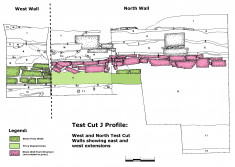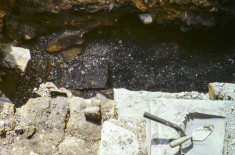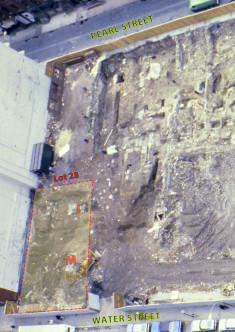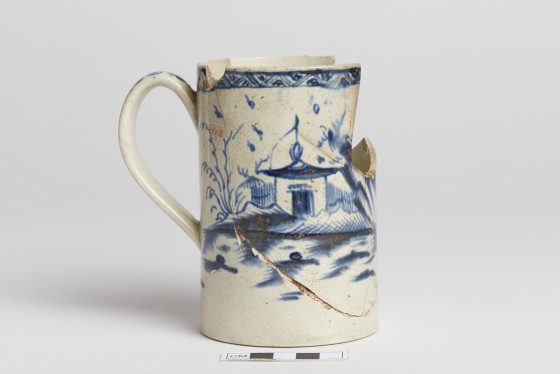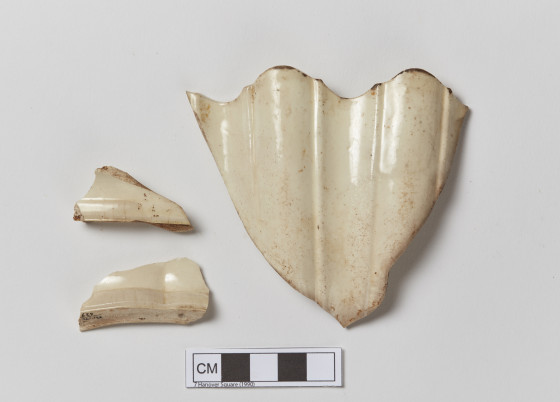This deposit consists of artifacts found from a privy feature located in the northern portion of Lot 28. The privy feature extended four feet east to west and the deposit within the feature extended beneath the stone wall in the northern portion of Test Cut J. This wall was not thought to be the northern portion of the feature but likely built after the feature. Although the excavation was extended north of the wall, the excavators were unable to determine the northern extent of the feature. The material excavated was probably deposited after the period of use had ended due to the lack of organic material present in the deposit. The feature contained a dense deposit of artifacts that were mostly domestic in nature, including bottle glass, table glass, and ceramics. Only 15 smoking pipe fragments were recovered in total from the feature, which is a stark contrast from the amounts found on other areas of the site. The presence of the window glass fragments were probably related to the occupation of one of the lot's residents, as discussed below. This deposit is unique among those excavated on the 7 Hanover Square site because of the large percentage (30.1% of the recovered sherds) of Chinese Export Porcelain. While precise data on the relative costs of porcelain and earthenware are lacking (Miller 1980), it is generally accepted that imported porcelain was more expensive and implied higher status than earthenwares. The large fraction of this deposit represented by Chinese Export Porcelain suggests that the residents of Lot 28 during the period represented by the feature deposit (or their ancestors) were fairly well-to-do.
A mean ceramic date of 1781.1 years was calculated based on the 704 datable ceramic sherds recovered from the feature. The absence of purely 19th century types suggests that deposition ended not long after the turn of the century. A deposition date during the 1790s or early 1800s accords with the documentary evidence further discussed below. It is also a possibility that this deposit accumulated gradually over a period of time rather than representing a single episode of dumping. For each of the four excavated levels of the deposit, we have calculated the mean ceramic date, the percentage of sherds with a final date of manufacture before 1780 and the percentage of sherds with an initial manufacture date between 1790 and 1800. Although these are scanty data they suggest the possibility that the privy feature was constructed during the early to mid-18th century and used until the late 18th to early 19th century. The excavated material from the feature would have been deposited after the period of use and after the privy deposits had been removed.
In 1790, Lot 28 was occupied by both Anthony Ogilvy, listed as a painter and glazier, and by Daniel Steddifor, a hairdresser. It should be recalled that the TC J feature contained 589 pieces of window glass, but few nails and little brick or mortar. If Ogilvy lived and worked on this lot we would expect to find both the refuse of daily life and refuse related to his occupation: the window glass. Thus, at least part of the refuse excavated from the feature may have been deposited by Ogilvy. Between 1793 and 1802, Stephen Smith, a hatter, occupied the lot and some of the refuse may have accumulated during his tenure. Between 1803 and 1832 the lot was occupied by Alexander McFarlane, also a hatter. However, between 1806 and 1813 George Conklin, a cooper, was noted as occupying a shed in the rear of the building. If this "shed" were in fact the building extension, the reconstruction of the building and the destruction of the feature could have taken place in the first decade of the 19th century. These data suggest that the feature material was deposited sometime between 1790 and 1806, which is in accord with the artifactual evidence previously discussed.
This context consists of artifacts excavated from the second level of the west side of the privy feature (Cat. #261: Lot 28, Test Cut J, Stratum 5, Level c). Additional levels of the privy were excavated to determine whether the deposit accumulated gradually or represented a single episode of dumping. For more information about the excavations in Lot 28 of the 7 Hanover Square excavation, please see pages 316-333 in the site report.
-
Collection method
This context was excavated using trowels. All of the soil was wet screened using 1/4 inch mesh.
-
Soil
Black charcoal
-
Soil description
The soil is stained black with large pieces of charcoal throughout. The stone wall to the north of the excavated area continues with depth.


